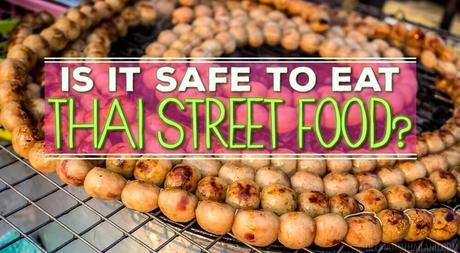
Our very first meal in Thailand - ever - was coughed up from a food stall on Bangkok's infamous Soi Cowboy. It was sometime after midnight and the vendor handed us a Styrofoam bowl filled with threadlike rice noodles, a clear pinkish broth (caused by the neon lighting?), a handful of rust red gelatinous squares (dyed tofu, perhaps?), and a few boiled chicken wings. We were hungry, traveled over thirty hours from the USA to Thailand, but nonetheless thought it was safe to eat Thai street food.
What happened to our GI tracts the next day? Well, nothing really. We got up bright and early, ate our 'safe' complimentary breakfast from our hotel around the corner from Soi Cowboy, and out we went to explore the streets of Bangkok.
What We Did Right
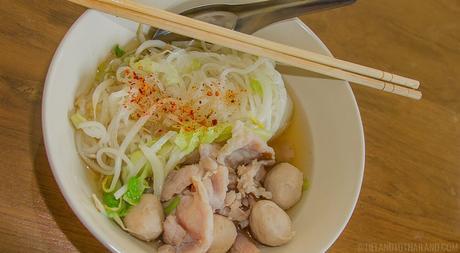
Were you expecting that we'd be spending the next 24 hours battling over the toilet and experiencing the equivalent of Delhi Belly or Montezuma's Revenge? In that case, we're sorry to disappoint you!
Maybe we got lucky with that particular bowl of noodles or maybe ordering from that vendor wasn't as reckless as it sounds. Eating at Thai street stalls, push carts, or food vendors seems to be synonymous with food poisoning, but that hasn't been our experience.
We think it's safe to eat Thai street food and would like to attribute our happy bellies that particular night (along with countless other evenings eating at food stalls) to several calculated decisions.
TIP 1: Look for the vendor with a long line
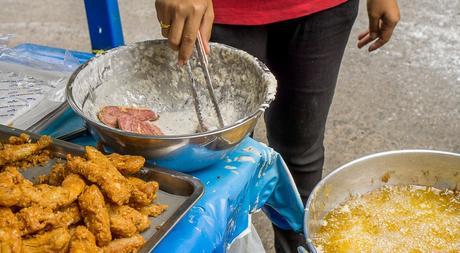
Long lines usually mean satisfied recurring customers. We aren't doubting that the food tastes good, but it's important that the people who are frequenting these stalls aren't getting sick. When looking at lines, we also give precedence to those that have several local Thais in them over lines solely composed of tourists. Not only does this suggest that the Thai street food is safe but that the flavors haven't been toned down to satisfy foreigners' palettes.
The night we were on Soi Cowboy we walked by several food stalls and most of them had few, if any, customers. We noticed one vendor with several Thai people standing in line so we gravitated there. Though we didn't have a clue to what the lady was serving, we figured that was a good a choice as any if she had several people waiting.
TIP 2: Buy cooked food that's hot
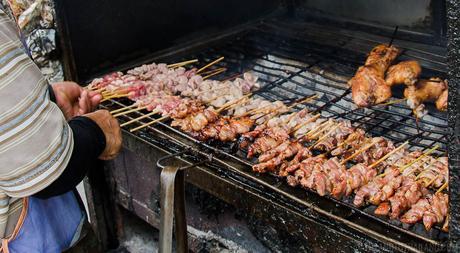
Aside from handmade ice-cream, fruit shakes, or fresh fruit, most vendors don't serve raw or chilled foods. Instead, there's a plethora of cooked food. Given that perpetually hot climates and open-aired dining areas are often attributed to an unpleasant experience in the bathroom later on, it's understandable why people question if it's safe to eat Thai street food.
To minimize the chance of an upset stomach, we typically pass on the bowls or pans of ready-made food that we've assumed to have been cooked hours in advance but are on display uncovered in the ambient temperature. The only exception is if we see the vendor just setting out the bowls and we're among the first customers of the day.
What we do eat are stir-fries that have been cooked in a sizzling wok right in front of us, skewers of meat, fish, or shellfish that are actively cooking on a fiery grill, or soups that have been ladled from a near-boiling cauldron. If it's served to us hot, we are more confident that any sneaky bacteria have been killed off. That's why the piping hot bowl of noodle soup from the Soi Cowboy vendor - regardless of its unfamiliar contents - was a seemingly safe choice.
TIP 3: Buy from a vendor that specializes in one type of food
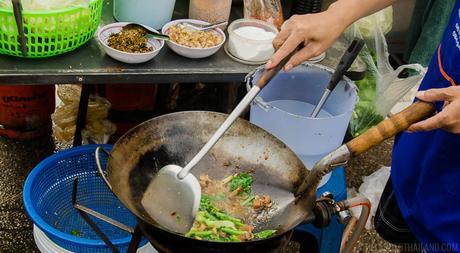
Thailand's tourist friendly restaurants (whether serving up Westernized Thai food or a Thai interpretation of Western food) are notorious for their book-sized menus. No joke, they often come in three-ringed binders! Chances are with 35 pages of entrées, ranging from lasagna to pad Thai to club sandwiches, not everything is fresh back in the kitchen. Yet many visitors choose to eat at these establishments over food stalls.
Most food stall vendors specialize in one food type, whether it's beef noodle soup, stewed pork leg, or banana roti and then offer a few variations. You can count on these vendors to buy their fresh ingredients regularly and then close up business when their stash runs out. With such a high turnover rate, there's less time for the ingredients to spoil. That's very different from the ground beef or semi-thawed shrimp that have sat in a restaurant's walk-in refrigerator for the past two weeks.
TIP 4: Use good judgement

Food hygiene standards in Thailand are different from Western countries - that's stating the obvious. You won't see vendors checking food temperatures with thermometers or dishes covered by food trays. There may even be *heaven forbid* street dogs or stray cats hanging around the food stalls.
So if you are browsing among food stall vendors, common sense goes a long way. Rather than jumping to the conclusion that these vendors are unhygienic and careless with how they handle the food, casually observe them before buying anything. Is the work station generally clean? Is the raw meat kept in a cooler before being cooked? Does the vendor use a different hand or tool to touch the food than the cash? Do the ingredients look bright and moist and not dull and limp? Are hundreds of people eating from the food stalls? If the answer is 'yes' to these questions, then order something!
TIP 5: Ice should have a hole in it
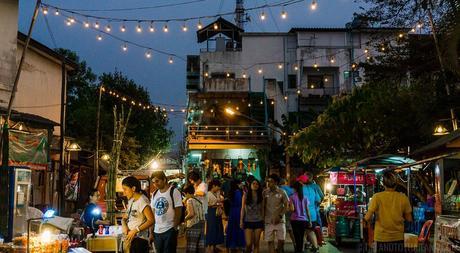
Many people fear the ice in Thailand. We can only image how many hot and thirsty visitors have turned down an iced drink in favor of a room temperature canned soda or a hot coffee because they were afraid the ice would make them sick.
Good news! It's possible to determine what ice is safe to drink in Thailand by its shape. We suggest steering clear of crushed ice and keep an eye out for ice that's in large, uniform pieces and that most often has a hole through it. That's a telltale sign that the cubes have been made from filtered water at an ice factory and not hacked or shaved from a block of ice with a potentially unsanitary blade.
When we sat down outside at one of the bars that flanked Soi Cowboy with our bowls of soups and ordered a round of beers (which is allowed in Thailand!) we were surprised to have two glasses of ice plopped down beside us. We had heard that it's customary to drink beer with ice because the beer warms up too quickly. As it turned out, the ice were large cylinders with a big hole down the middle. When in Rome!
TIP 6: Drink bottled water
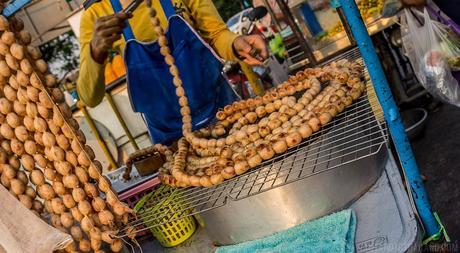
Drinking bottled water in Thailand is the way to go. Accessibility won't be a problem because the locals drink it, too, particularly in major towns that have proper bottled water distribution shops. But most vendors don't sell plastic bottles of water at their stalls. Instead, vendors set up free, self-serve coolers filled with filtered water and safe ice.
Keep your eyes out for a rack of metal or plastic cups to drink from and a large, typically round cooler beside it. The cooler either directly dispenses water or it has a removable top with which water can be scooped out with a ladle. An obvious sign that filtered water has been used is the 40L water jug (similar to the kind at your office's watering hole back home) sitting off to the side of the vendor, which was purchased from a bottled water facility.
Have we ever gotten sick?
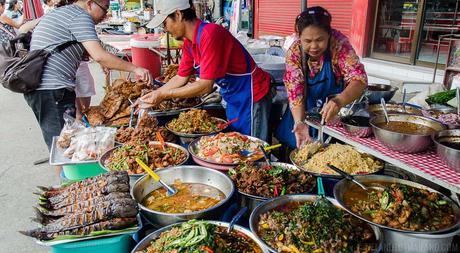
Yes, in the three years living here, we both have gotten sick. Chris once and I twice. We weren't able to avoid stomach bugs entirely.
Within a few months of officially moving to Thailand, I had a one week-long stomach illness that resulted in regular intervals of stabbing stomach pains. The culprit was either a mango and yogurt shake or a shrimp a vegetable stir-fry from street stalls in Chiang Mai. The second time I got sick was from chicken I cooked from scratch at home and ended up going to the pharmacist down the street for antibiotics. Chris, on the other hand, just recently had a 36 hour debilitating bug (we'll spare you the details) after eating a charcuterie and cheese plate at an Italian restaurant in Krabi.
All three situations were different - once from a food stall, once from an upscale restaurant, and once from a home cooked meal - and all were supposedly 'safe' because there no obvious signs to us that the food was spoiled or that it had been mishandled. But sh*t happens, pun intended!
This is not to say that every other time we've eaten Thai food things have been, er, regular. It took our stomachs about one month of eating Thai street food once every other day to adjust to the flood of new ingredients and different strains of bacteria on the other side of the world. Even if we had previously believed to have possessed iron stomachs.
To this day we aren't sure what type of noodle soup we ate on Soi Cowboy, although we've figured out the rust colored 'tofu' squares were really blood cake and suspect the pink broth was colored by red bean paste. But we figured we must have made some smart decisions that night and it certainly makes for an entertaining story!
Do you worry that it's not safe to eat Thai street food? What is your biggest concern?
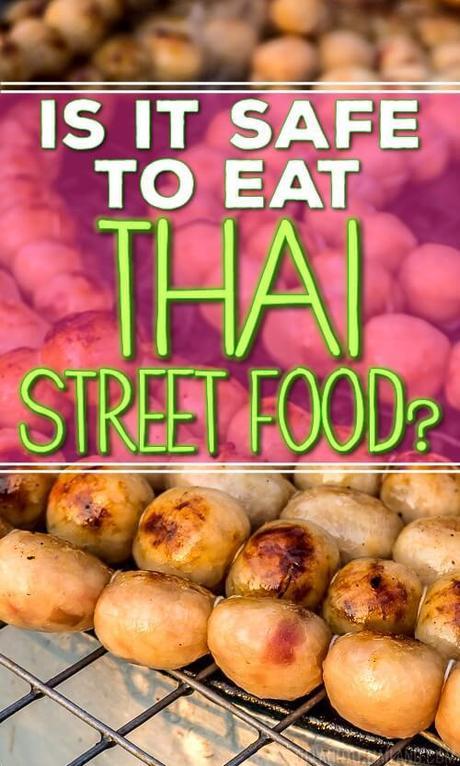

Chris and Angela sold everything, paid off their debt, and ultimately figured a way out of the nine to five grind in the United States. Today they are living full time in Chiang Mai, Thailand, guiding and inspiring future expats towards amazing lives abroad! For more updates follow them on , , and . To see a full list of posts check out the .

